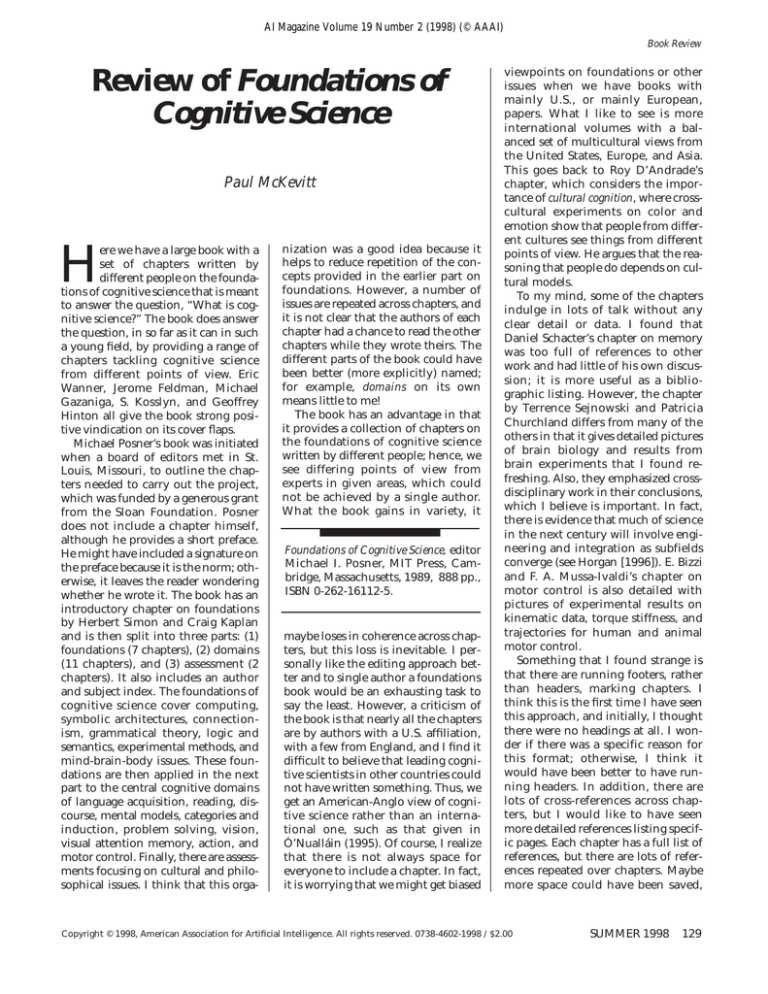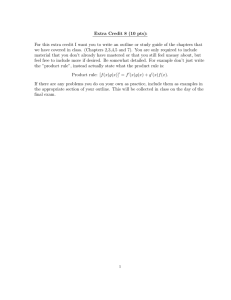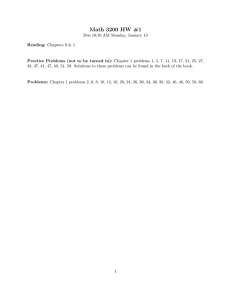
AI Magazine Volume 19 Number 2 (1998) (© AAAI)
Book Review
Review of Foundations of
Cognitive Science
Paul McKevitt
H
ere we have a large book with a
set of chapters written by
different people on the foundations of cognitive science that is meant
to answer the question, “What is cognitive science?” The book does answer
the question, in so far as it can in such
a young field, by providing a range of
chapters tackling cognitive science
from different points of view. Eric
Wanner, Jerome Feldman, Michael
Gazaniga, S. Kosslyn, and Geoffrey
Hinton all give the book strong positive vindication on its cover flaps.
Michael Posner’s book was initiated
when a board of editors met in St.
Louis, Missouri, to outline the chapters needed to carry out the project,
which was funded by a generous grant
from the Sloan Foundation. Posner
does not include a chapter himself,
although he provides a short preface.
He might have included a signature on
the preface because it is the norm; otherwise, it leaves the reader wondering
whether he wrote it. The book has an
introductory chapter on foundations
by Herbert Simon and Craig Kaplan
and is then split into three parts: (1)
foundations (7 chapters), (2) domains
(11 chapters), and (3) assessment (2
chapters). It also includes an author
and subject index. The foundations of
cognitive science cover computing,
symbolic architectures, connectionism, grammatical theory, logic and
semantics, experimental methods, and
mind-brain-body issues. These foundations are then applied in the next
part to the central cognitive domains
of language acquisition, reading, discourse, mental models, categories and
induction, problem solving, vision,
visual attention memory, action, and
motor control. Finally, there are assessments focusing on cultural and philosophical issues. I think that this orga-
nization was a good idea because it
helps to reduce repetition of the concepts provided in the earlier part on
foundations. However, a number of
issues are repeated across chapters, and
it is not clear that the authors of each
chapter had a chance to read the other
chapters while they wrote theirs. The
different parts of the book could have
been better (more explicitly) named;
for example, domains on its own
means little to me!
The book has an advantage in that
it provides a collection of chapters on
the foundations of cognitive science
written by different people; hence, we
see differing points of view from
experts in given areas, which could
not be achieved by a single author.
What the book gains in variety, it
Foundations of Cognitive Science, editor
Michael I. Posner, MIT Press, Cambridge, Massachusetts, 1989, 888 pp.,
ISBN 0-262-16112-5.
maybe loses in coherence across chapters, but this loss is inevitable. I personally like the editing approach better and to single author a foundations
book would be an exhausting task to
say the least. However, a criticism of
the book is that nearly all the chapters
are by authors with a U.S. affiliation,
with a few from England, and I find it
difficult to believe that leading cognitive scientists in other countries could
not have written something. Thus, we
get an American-Anglo view of cognitive science rather than an international one, such as that given in
Ó’Nualláin (1995). Of course, I realize
that there is not always space for
everyone to include a chapter. In fact,
it is worrying that we might get biased
viewpoints on foundations or other
issues when we have books with
mainly U.S., or mainly European,
papers. What I like to see is more
international volumes with a balanced set of multicultural views from
the United States, Europe, and Asia.
This goes back to Roy D’Andrade’s
chapter, which considers the importance of cultural cognition, where crosscultural experiments on color and
emotion show that people from different cultures see things from different
points of view. He argues that the reasoning that people do depends on cultural models.
To my mind, some of the chapters
indulge in lots of talk without any
clear detail or data. I found that
Daniel Schacter’s chapter on memory
was too full of references to other
work and had little of his own discussion; it is more useful as a bibliographic listing. However, the chapter
by Terrence Sejnowski and Patricia
Churchland differs from many of the
others in that it gives detailed pictures
of brain biology and results from
brain experiments that I found refreshing. Also, they emphasized crossdisciplinary work in their conclusions,
which I believe is important. In fact,
there is evidence that much of science
in the next century will involve engineering and integration as subfields
converge (see Horgan [1996]). E. Bizzi
and F. A. Mussa-Ivaldi’s chapter on
motor control is also detailed with
pictures of experimental results on
kinematic data, torque stiffness, and
trajectories for human and animal
motor control.
Something that I found strange is
that there are running footers, rather
than headers, marking chapters. I
think this is the first time I have seen
this approach, and initially, I thought
there were no headings at all. I wonder if there was a specific reason for
this format; otherwise, I think it
would have been better to have running headers. In addition, there are
lots of cross-references across chapters, but I would like to have seen
more detailed references listing specific pages. Each chapter has a full list of
references, but there are lots of references repeated over chapters. Maybe
more space could have been saved,
Copyright © 1998, American Association for Artificial Intelligence. All rights reserved. 0738-4602-1998 / $2.00
SUMMER 1998
129
Book Review
and cost reduced, by having one reference section at the back of the book.
Many of the leading lights in cognitive science are authors here: Bower,
Churchland, Grosz, Johnson-Laird,
Jordan, Newell, Pinker, Pylyshyn,
Rumelhart, Sejnowski, and Simon.
However, I missed a chapter by Roger
Schank, or any of his school (for
example, De Jong, Dyer, Lehnert,
Wilensky), who is undoubtedly one of
the leaders in this field. Schank’s views
on language understanding, pragmatics, and natural language processing
had people think again about Chomsky’s focus on the primacy of syntax.
Posner’s book is fair to both the symbolic-connectionist and the logic
(“neat”)-nonlogic (“scruffy”) traditions in cognitive science because it
includes chapters from all these
camps. All the classic issues are discussed, such as the fact that people do
not reason logically well (Wason card
test), requiring more (for example,
mental models) than neat logic to
model cognition.
I am happy to see that nearly all the
classical issues of cognitive science are
covered (and sometimes by more than
one chapter), including (1) the Turing
test; (2) Searle’s Chinese room problem; (3) Marr’s three-level hypothesis
(in many chapters); (4) Newell and
Simon’s physical symbol system
hypothesis; (5) computer architecture
as a metaphor for cognitive architecture; (6) Wittgenstein and Rosch’s category theory; (7) schemas, frames, and
scripts (Bartlett, Minsky, Schank) (in
many chapters); (8) representation as
language propositions or images
(Kosslyn, Pylyshyn); (9) people not
reasoning logically (Wason, JohnsonLaird); (10) procedural-declarative representations; (11) Minsky and Papert’s
1969 death knell to connectionism;
and (12) Miller’s 7 +/– 2 value for
short-term memory.
Simon and Kaplan’s introductory
chapter on the foundations of cognitive science is good, going over the
central classic issues and listing the
main contributing disciplines as psychology; AI; linguistics; philosophy;
neuroscience; and, to a lesser extent,
anthropology and social psychology.
They take the expected swipe at
behaviorism, although they do not
130
AI MAGAZINE
mention or reference Skinner at all
who was one of its main proponents.
Methodology (protocol analysis, content analysis, AI–computer simulation
metaanalysis) and philosophy, systems that adapt to their environments, and learning and social cognition are also covered.
Simon and Kaplan discuss some of
the tricky issues in cognitive science,
such as whether people’s knowledge
representations are language-propositions or something else such as images
and how the semantic components of
language and vision are related. They
say, “What is the relation between the
meaning that is extracted from the
sentence there is a cat in this room and
the meaning that is extracted from
seeing a cat in the room?” (p. 16); they
favor the hypothesis that there is one
unified meaning representation. For
more recent discussions on integration of language and vision processing
with an AI slant, see Srihari (1995).
I found interesting Jon Barwise and
John Etchemendy’s design of a simple
language called OLD ZELANADISH, which
is a hybrid of first-order logic and
English, in their chapter on formal
logic. It is similar enough to familiar
languages to be able to guess the
intended meanings but different
enough to remind us that it is not
English. Such constructions are
invaluable for building up explanations.
For me, the final two chapters on
analysis are the most useful, with Roy
D’Andrade stressing modeling culture,
where cultural models are to some
extent “little machines” (p. 824). We
get a full discussion on the moves
toward cognitive linguistics, as advocated by Talmy, Langacker, and Lakoff.
Also, two topics come up here that are
important for cognitive science to
address more in the future: (1) color
and (2) emotion. I would like to see
cognitive science conduct more work
on emotional intelligence (see Goleman [1996]), where emotion is given a
higher priority. In accordance with
D’Andrade, Ó’Nualláin (1995) stresses
the need for more focus on embodiment and social interaction in cognitive science. Gilbert Harman’s chapter
focuses on the philosophical issues of
qualia, intentionality, and the mind-
body problem. Dennett’s work on
intentionality and Searle’s Chinese
room problem are discussed thoroughly here.
Posner’s book provides a solid foundation for a field that is now well
established and part of the ongoing
effort to understand the self, mind,
and consciousness. In fact, the understanding of consciousness takes front
seat in cognitive science now (see
Ó’Nualláin, Mc Kevitt, and Mac
Aogáin [1997]). Posner’s book is a
valuable one for students and others
who want to know about the foundations of cognitive science.
References
Goleman, D. 1996. Emotional Intelligence:
Why It Can Matter More Than IQ. London,
U.K.: Bloomsbury.
Horgan, J. 1996. The End of Science: Facing
the Limits of Knowledge in the Twilight of the
Scientific Age. Reading, Mass.: Addison-Wesley.
Ó’Nualláin, S. 1995. The Search for Mind: A
New Foundation for Cognitive Science. Norwood, N.J.: Ablex.
Ó’Nualláin, S.; Mc Kevitt, P.; and Mac
Aogáin, E., editors. 1997. Two Sciences of
Mind: Readings in Cognitive Science and Consciousness. Advances in Consciousness
Research (AiCR 9). Philadelphia, Pa.: John
Benjamins.
Srihari, R. 1995. Computational Models for
Integrating Linguistic and Visual Information: A Survey. In Integration of Natural Language and Vision Processing, Volume 1: Computational Models and Systems, ed. Paul Mc
Kevitt, 185–205. Dordrecht, The Netherlands: Kluwer Academic.
Paul Mc Kevitt is visiting professor of intelligent multimedia computing at Aalborg
University, Denmark, and a British EPSRC
advanced fellow in the Department of
Computer Science at the University of
Sheffield, England. He is currently completing a Master’s degree in education at the
University of Sheffield, has his Ph.D. from
the University of Exeter, England (1991),
an M.S. from New Mexico State University
(1988), and a B.Sc. (Hons.) from University
College, Dublin, Ireland (1985), all in computer science. His primary research interests are in natural language processing,
including the processing of pragmatics and
beliefs and intentions in dialogue, and he is
also interested in philosophy, multimedia,
and the general area of AI. His e-mail
address is pmck@cpk.auc.dk.





